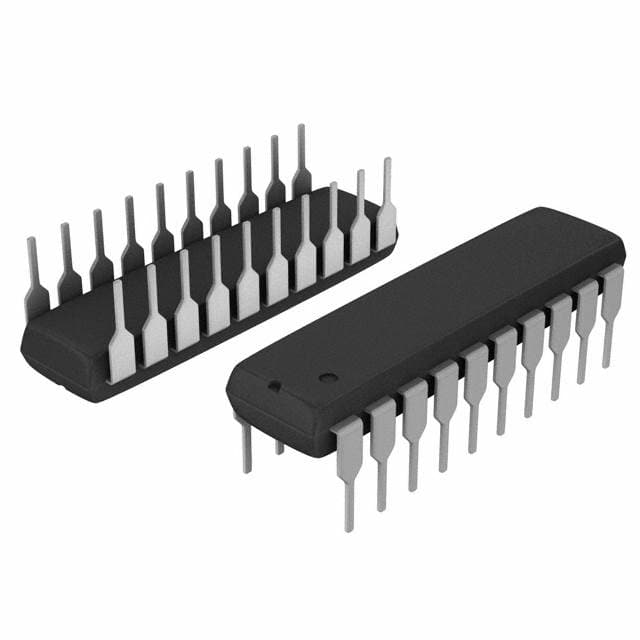Consulte las especificaciones para obtener detalles del producto.

AT89C1051U-12PI
Product Overview
Category
The AT89C1051U-12PI belongs to the category of microcontrollers.
Use
This microcontroller is commonly used in various electronic applications that require embedded control systems.
Characteristics
- Low-power, high-performance CMOS 8-bit microcontroller
- 1K bytes of Flash memory
- 128 bytes of RAM
- 15 programmable I/O lines
- Two 16-bit timer/counters
- Six interrupt sources
- Programmable serial UART channel
- On-chip oscillator and clock circuitry
Package
The AT89C1051U-12PI is available in a 20-pin DIP (Dual Inline Package) format.
Essence
The essence of the AT89C1051U-12PI microcontroller lies in its ability to provide efficient and reliable control for a wide range of electronic devices and systems.
Packaging/Quantity
The AT89C1051U-12PI is typically packaged in tubes or trays, with quantities varying based on customer requirements.
Specifications
- Operating Voltage: 2.7V to 6V
- Maximum CPU Clock Frequency: 12 MHz
- Flash Memory Size: 1K bytes
- RAM Size: 128 bytes
- Number of I/O Lines: 15
- Timer/Counter: Two 16-bit timers/counters
- Interrupt Sources: Six
- Serial Communication: Programmable UART channel
Detailed Pin Configuration
The AT89C1051U-12PI microcontroller has a total of 20 pins, each serving a specific purpose. The pin configuration is as follows:
- P1.0 - Port 1, Pin 0
- P1.1 - Port 1, Pin 1
- P1.2 - Port 1, Pin 2
- P1.3 - Port 1, Pin 3
- P1.4 - Port 1, Pin 4
- P1.5 - Port 1, Pin 5
- P1.6 - Port 1, Pin 6
- P1.7 - Port 1, Pin 7
- RST - Reset Pin
- XTAL1 - Crystal Oscillator Input
- XTAL2 - Crystal Oscillator Output
- GND - Ground
- P3.0 - Port 3, Pin 0
- P3.1 - Port 3, Pin 1
- P3.2 - Port 3, Pin 2
- P3.3 - Port 3, Pin 3
- P3.4 - Port 3, Pin 4
- P3.5 - Port 3, Pin 5
- VCC - Supply Voltage
- PSEN - Program Store Enable
Functional Features
The AT89C1051U-12PI microcontroller offers several functional features that make it a versatile choice for embedded control systems:
- Flash Memory: The built-in 1K bytes of Flash memory allows for easy program storage and modification.
- RAM: With 128 bytes of RAM, the microcontroller can efficiently handle data processing tasks.
- I/O Lines: The 15 programmable I/O lines provide flexibility in connecting external devices and sensors.
- Timer/Counters: Two 16-bit timer/counters enable precise timing and event counting capabilities.
- Interrupt Sources: The microcontroller supports six interrupt sources, allowing for efficient handling of external events.
- Serial Communication: The programmable UART channel facilitates serial communication with other devices.
Advantages and Disadvantages
Advantages
- Low-power consumption, making it suitable for battery-powered applications.
- Compact size and easy integration into various electronic systems.
- Wide operating voltage range allows for flexibility in power supply options.
- Ample program and data storage capabilities.
- Support for serial communication simplifies connectivity with other devices.
Disadvantages
- Limited Flash memory capacity compared to higher-end microcontrollers.
- Relatively lower clock frequency may restrict performance in demanding applications.
- Limited number of I/O lines may pose constraints in complex projects.
Working Principles
The AT89C1051U-12PI microcontroller operates based on the principles of a typical 8-bit microcontroller. It executes instructions stored in its Flash memory, processes data using its RAM, and interacts with external devices through its I/O lines. The built-in timers/counters and interrupt handling mechanisms enable precise timing and event-driven operations. The microcontroller's working principle revolves around executing instructions sequentially, responding to external events, and controlling connected devices as per the programmed logic.
Detailed Application Field Plans
The AT89C1051U-12PI
Enumere 10 preguntas y respuestas comunes relacionadas con la aplicación de AT89C1051U-12PI en soluciones técnicas
Sure! Here are 10 common questions and answers related to the application of AT89C1051U-12PI in technical solutions:
Q: What is the AT89C1051U-12PI microcontroller? A: The AT89C1051U-12PI is a high-performance, low-power 8-bit microcontroller from Atmel.
Q: What are the key features of the AT89C1051U-12PI? A: Some key features include 1K bytes of Flash memory, 64 bytes of RAM, 15 programmable I/O lines, and a 12 MHz operating frequency.
Q: What are some typical applications of the AT89C1051U-12PI? A: It is commonly used in applications such as industrial control systems, home automation, robotics, and various embedded systems.
Q: How can I program the AT89C1051U-12PI microcontroller? A: You can use an In-System Programmer (ISP) or a compatible development board with a programming interface to program the microcontroller.
Q: What programming languages can be used to program the AT89C1051U-12PI? A: The microcontroller supports assembly language programming, as well as higher-level languages like C or BASIC.
Q: Can I interface external devices with the AT89C1051U-12PI? A: Yes, the microcontroller has multiple I/O pins that can be used to interface with sensors, actuators, displays, and other external devices.
Q: What is the maximum voltage that the AT89C1051U-12PI can handle? A: The microcontroller can handle a maximum supply voltage of 6V.
Q: Does the AT89C1051U-12PI have any built-in communication interfaces? A: No, it does not have any built-in communication interfaces. However, you can implement serial communication using software UART.
Q: Can I use the AT89C1051U-12PI in battery-powered applications? A: Yes, the microcontroller's low-power consumption makes it suitable for battery-powered applications.
Q: Are there any development tools or IDEs available for programming the AT89C1051U-12PI? A: Yes, there are various development tools and IDEs available, such as Atmel Studio, Keil µVision, and SDCC (Small Device C Compiler).
Please note that these answers are general and may vary depending on specific requirements and implementation details.

